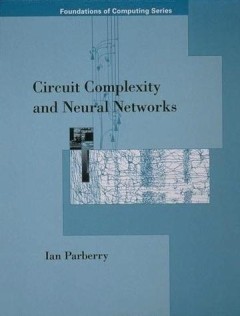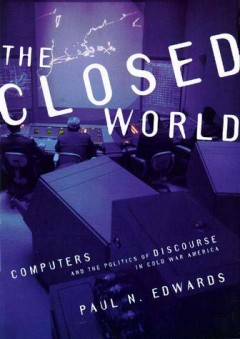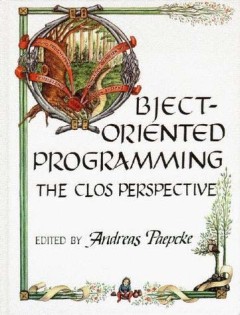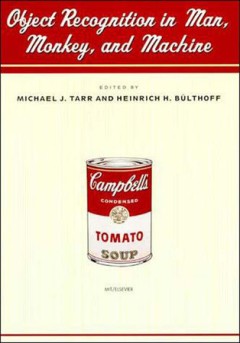Filter by

Circuit Complexity and Neural Networks
Neural networks usually work adequately on small problems but can run into trouble when they are scaled up to problems involving large amounts of input data. Circuit Complexity and Neural Networks addresses the important question of how well neural networks scale - that is, how fast the computation time and number of neurons grow as the problem size increases. It surveys recent research in circ…
- Edition
- -
- ISBN/ISSN
- 9780262281249
- Collation
- 1 online resource (xxix, 270 pages) :illustrations.
- Series Title
- -
- Call Number
- -

City of Bits : Space, Place, and the Infobahn
Entertaining, concise, and relentlessly probing, City of Bits is a comprehensive introduction to a new type of city, an increasingly important system of virtual spaces interconnected by the information superhighway. William Mitchell makes extensive use of practical examples and illustrations in a technically well-grounded yet accessible examination of architecture and urbanism in the context of…
- Edition
- -
- ISBN/ISSN
- 9780262279956
- Collation
- -
- Series Title
- -
- Call Number
- 720 MIT c

The Closed World: Computers and the Politics of Discourse in Cold War America
The Closed World offers a radically new alternative to the canonical histories of computers and cognitive science. Arguing that we can make sense of computers as tools only when we simultaneously grasp their roles as metaphors and political icons, Paul Edwards shows how Cold War social and cultural contexts shaped emerging computer technology--and were transformed, in turn, by information machi…
- Edition
- -
- ISBN/ISSN
- 9780262272162
- Collation
- 1 online resource (xx, 440 pages) :illustrations.
- Series Title
- -
- Call Number
- -

The Trouble with Computers: Usefulness, Usability, and Productivity
A Bradford book."OCLC-licensed vendor bibliographic record.
- Edition
- -
- ISBN/ISSN
- 9780262277891
- Collation
- 1 online resource (xiii, 425 pages) :illustrations
- Series Title
- -
- Call Number
- -

Certified Programming with Dependent Types: A Pragmatic Introduction to the C…
A handbook to the Coq software for writing and checking mathematical proofs, with a practical engineering focus. The technology of mechanized program verification can play a supporting role in many kinds of research projects in computer science, and related tools for formal proof-checking are seeing increasing adoption in mathematics and engineering. This book provides an introduction to the Co…
- Edition
- -
- ISBN/ISSN
- 9780262026659
- Collation
- -
- Series Title
- -
- Call Number
- -

New directions in statistical signal processing :from systems to brain
Signal processing and neural computation have separately and significantly influenced many disciplines, but the cross-fertilization of the two fields has begun only recently. Research now shows that each has much to teach the other, as we see highly sophisticated kinds of signal processing and elaborate hierachical levels of neural computation performed side by side in the brain. In New Directi…
- Edition
- -
- ISBN/ISSN
- 9780262256315
- Collation
- 1 online resource (vi, 514 pages) :illustrations.
- Series Title
- -
- Call Number
- -

New media poetics :contexts, technotexts, and theories
The first collection of writings on poetry that is composed, disseminated, and read on computers; essays and artist statements explore visually arresting, aurally charged, and dynamic works that are created by a synergy of human beings and intelligent mac.OCLC-licensed vendor bibliographic record.
- Edition
- -
- ISBN/ISSN
- 9780262280211
- Collation
- 1 online resource (xii, 425 pages) :illustrations.
- Series Title
- -
- Call Number
- -

Ideas that created the future :classic papers of computer science
"An anthology of classic papers in computer science with introductions by the editor"--OCLC-licensed vendor bibliographic record.
- Edition
- -
- ISBN/ISSN
- 0262363178
- Collation
- 1 online resource.
- Series Title
- -
- Call Number
- -

Object-oriented programming :the CLOS perspective
To date, books on object-oriented programming have focused either on the methodology of the object-oriented paradigm or on teaching the details of a particular programming language. This collection takes a different approach, examining one object-oriented programming language - the Common-Lisp Object System (CLOS) - as a modern programming tool. The fourteen contributions examine CLOS from a va…
- Edition
- -
- ISBN/ISSN
- 9780262256759
- Collation
- 1 online resource (viii, 352 pages) :illustrations
- Series Title
- -
- Call Number
- -

Object recognition in man, monkey, and machine
The contributors bring a wide range of methodologies to bear on the common problem of image-based object recognition. These interconnected essays on three-dimensional visual object recognition present cutting-edge research by some of the most creative neuroscientific, cognitive, and computational scientists in the field. Cassandra Moore and Patrick Cavanagh take a classic demonstration, t…
- Edition
- -
- ISBN/ISSN
- 9780262287609
- Collation
- 1 online resource (217 pages) :illustrations.
- Series Title
- -
- Call Number
- -
 Computer Science, Information & General Works
Computer Science, Information & General Works  Philosophy & Psychology
Philosophy & Psychology  Religion
Religion  Social Sciences
Social Sciences  Language
Language  Pure Science
Pure Science  Applied Sciences
Applied Sciences  Art & Recreation
Art & Recreation  Literature
Literature  History & Geography
History & Geography